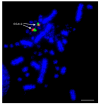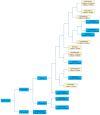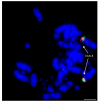A Bird's-Eye View of Chromosomic Evolution in the Class Aves
- PMID: 38391923
- PMCID: PMC10886771
- DOI: 10.3390/cells13040310
A Bird's-Eye View of Chromosomic Evolution in the Class Aves
Abstract
Birds (Aves) are the most speciose of terrestrial vertebrates, displaying Class-specific characteristics yet incredible external phenotypic diversity. Critical to agriculture and as model organisms, birds have adapted to many habitats. The only extant examples of dinosaurs, birds emerged ~150 mya and >10% are currently threatened with extinction. This review is a comprehensive overview of avian genome ("chromosomic") organization research based mostly on chromosome painting and BAC-based studies. We discuss traditional and contemporary tools for reliably generating chromosome-level assemblies and analyzing multiple species at a higher resolution and wider phylogenetic distance than previously possible. These results permit more detailed investigations into inter- and intrachromosomal rearrangements, providing unique insights into evolution and speciation mechanisms. The 'signature' avian karyotype likely arose ~250 mya and remained largely unchanged in most groups including extinct dinosaurs. Exceptions include Psittaciformes, Falconiformes, Caprimulgiformes, Cuculiformes, Suliformes, occasional Passeriformes, Ciconiiformes, and Pelecaniformes. The reasons for this remarkable conservation may be the greater diploid chromosome number generating variation (the driver of natural selection) through a greater possible combination of gametes and/or an increase in recombination rate. A deeper understanding of avian genomic structure permits the exploration of fundamental biological questions pertaining to the role of evolutionary breakpoint regions and homologous synteny blocks.
Keywords: avian genome; avian karyotype; interchromosomal rearrangements; intrachromosomal rearrangements; macrochromosomes; microchromosomes.
Conflict of interest statement
The authors declare no conflicts of interest.
Figures








References
-
- Gill F., Donsker D., Rasmussen P., editors. IOC World Bird List (v12.2) 2022. [(accessed on 1 November 2023)]. Available online: https://www.worldbirdnames.org/new/
-
- Farrar V.S., Flores L., Viernes R.C., Pereira L.O., Mushtari S., Calisi R.M. Prolactin promotes parental responses and alters reproductive axis gene expression, but not courtship behaviors, in both sexes of a biparental bird. Horm. Behav. 2022;144:105217. doi: 10.1016/j.yhbeh.2022.105217. - DOI - PubMed
Publication types
MeSH terms
Grants and funding
LinkOut - more resources
Full Text Sources

